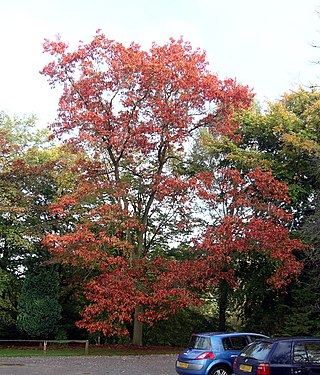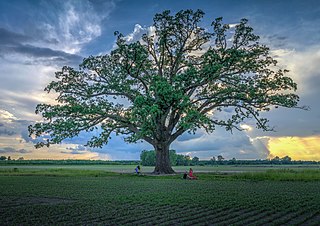
Quercus rubra, the northern red oak, is an oak tree in the red oak group. It is a native of North America, in the eastern and central United States and southeast and south-central Canada. It has been introduced to small areas in Western Europe, where it can frequently be seen cultivated in gardens and parks. It prefers good soil that is slightly acidic. Often simply called red oak, northern red oak is so named to distinguish it from southern red oak (Q. falcata), also known as the Spanish oak. Northern red oak is sometimes called champion oak.

Quercus montana, the chestnut oak, is a species of oak in the white oak group, Quercus sect. Quercus. It is native to the eastern United States, where it is one of the most important ridgetop trees from southern Maine southwest to central Mississippi, with an outlying northwestern population in southern Michigan. It is also sometimes called rock oak because of its presence in montane and other rocky habitats.

Quercus alba, the white oak, is one of the preeminent hardwoods of eastern and central North America. It is a long-lived oak, native to eastern and central North America and found from Minnesota, Ontario, Quebec, and southern Maine south as far as northern Florida and eastern Texas. Specimens have been documented to be over 450 years old.

Mercer County is a county located in the U.S. state of New Jersey. Its county seat is Trenton, also the state capital, prompting its nickname The Capital County. Mercer County alone constitutes the Trenton–Princeton metropolitan statistical area and is considered part of the New York combined statistical area by the U.S. Census Bureau, but also directly borders the Philadelphia metropolitan area and is included within the Federal Communications Commission's Philadelphia Designated Media Market Area. The county is part of the Central Jersey region of the state.

Quercus cerris, the Turkey oak or Austrian oak, is an oak native to south-eastern Europe and Asia Minor. It is the type species of Quercus sect. Cerris, a section of the genus characterised by shoot buds surrounded by soft bristles, bristle-tipped leaf lobes, and acorns that usually mature in 18 months.

The Royal Oak was the English oak tree within which the future King Charles II of England hid to escape the Roundheads following the Battle of Worcester in 1651. The tree was in Boscobel Wood, which was part of the park of Boscobel House. Charles told Samuel Pepys in 1680 that while he was hiding in the tree, a Parliamentarian soldier passed directly below it. The story was popular after the Restoration, and is remembered every year in the English traditions of Royal Oak Day.

Quercus macrocarpa, the bur oak or burr oak, is a species of oak tree native to eastern North America. It is in the white oak section, Quercus sect. Quercus, and is also called mossycup oak, mossycup white oak, blue oak, or scrub oak. The acorns are the largest of any North American oak, and are important food for wildlife.

The Wye Oak was the largest white oak tree in the United States and the State Tree of Maryland from 1941 until its demise in 2002. Wye Oak State Park preserves the site where the revered tree stood for more than 400 years in the town of Wye Mills, Talbot County, Maryland.

Quercus coccinea, the scarlet oak, is a deciduous tree in the red oak section Lobatae of the genus Quercus, in the family Fagaceae.

Quercus acutissima, the sawtooth oak, is an Asian species of oak native to China, Tibet, Korea, Japan, Indochina and the Himalayas. It is widely planted in many lands and has become naturalized in parts of North America.

Quercus lobata, commonly called the valley oak or roble, is the largest of the California oaks. It is endemic to the state, growing in interior valleys and foothills from Siskiyou to San Diego counties. Deciduous, it requires year-round groundwater, and may live up to 600 years. Its thick, ridged bark and deeply lobed leaves are characteristic, and assist in identification.

Holwood House is a 25,060-square-foot (2,328 m2) country house in Keston, near Hayes, in the London Borough of Bromley, England. The house was designed by Decimus Burton, built between 1823 and 1826 and is in the Greek Revival style. It was built for John Ward, who later employed Burton to lay out his Calverley Park Estate in Tunbridge Wells. The gate lodges of that estate take their names from the gate lodges on the Holwood Estate – Farnborough Lodge and Keston Lodge.

The Washington Oak is a protected ancient white oak tree in Princeton, New Jersey, USA that overlooks the Princeton Battlefield State Park. The International Society of Arboriculture and the Tree Care Industry Association jointly recognize the Washington Oak as having lived at the time of the signing of the United States Constitution in 1787.

The Presbyterian Church in Basking Ridge is a historic church at 1 E. Oak Street in the Basking Ridge section of Bernards Township in Somerset County, New Jersey, United States. The church congregation was founded in 1717. The present church, which was constructed in 1839 in a Greek Revival style, is listed in the U.S. National Register of Historic Places. Until 2017, the churchyard held the Old Oak Tree of Basking Ridge, which was estimated to be 600 years old.

Friendship Oak is a 500-year-old southern live oak located on the Gulf Park campus of the University of Southern Mississippi in Long Beach, Mississippi. The campus was formerly Gulf Park College for Women from 1921 until 1971.
The Bruce Tree was an oak tree that stood on the grounds of Strathleven House in Dunbartonshire, Scotland. It is reputed to have been planted by Robert the Bruce and was between 700 and 1,000 years old when it fell from an arson attack in May 2004. The timber from the tree was saved and used to form a replica of the Bruce's throne.

The Caton Oak was an ancient oak tree that stood in Caton, Lancashire, reputedly dating from the time of the druids. The oak tree stood atop a set of steps known as the "Fish Stones" that were used by medieval monks to display salmon for sale. The tree declined during the 20th century and was reinforced with a metal support; an acorn from the tree was planted in 2007 to grow a replacement. The original Caton Oak fell on 20 June 2016.

The Shelton Oak, also known as Owen Glendwr's Observatory or the Glendower Oak, was a veteran oak tree near Shrewsbury, England. It may be the "grette Oak at Shelton" mentioned in a document from the time of Henry III (1216–1272). The oak is said to have been climbed by Owain Glyndŵr to view the 1403 Battle of Shrewsbury, from which its alternative name derives. In later years the tree became renowned for its hollow trunk which was variously described as able to accommodate twenty people, six people sitting for dinner or an eight-person quadrille dance. The tree had fallen by 1940 and its remains were removed in the 1950s to facilitate improvements to an adjacent road junction.

The Newland Oak was a veteran oak tree in Newland, Gloucestershire in England. Originally part of the ancient woodland of the Forest of Dean, it survived clearances that created the settlement of Newland and was afterwards pollarded for timber. Its large size was often remarked upon through the years and it was considered a rival to the Cowthorpe Oak as the largest oak tree in Great Britain. Much of the tree fell during heavy snow in 1955 but a single branch of the tree survived until 1970 when it was killed during an arson attack. A replacement tree grown from one of the Newland Oak's acorns had been planted in 1964.

The Basking Ridge white oak was a white oak tree that stood in the churchyard of the Presbyterian Church in Basking Ridge, New Jersey. The tree was over 600 years old and died in 2016, before being cut down in 2017. It stood at 97 feet tall, and may have been the oldest white oak in the world.




















